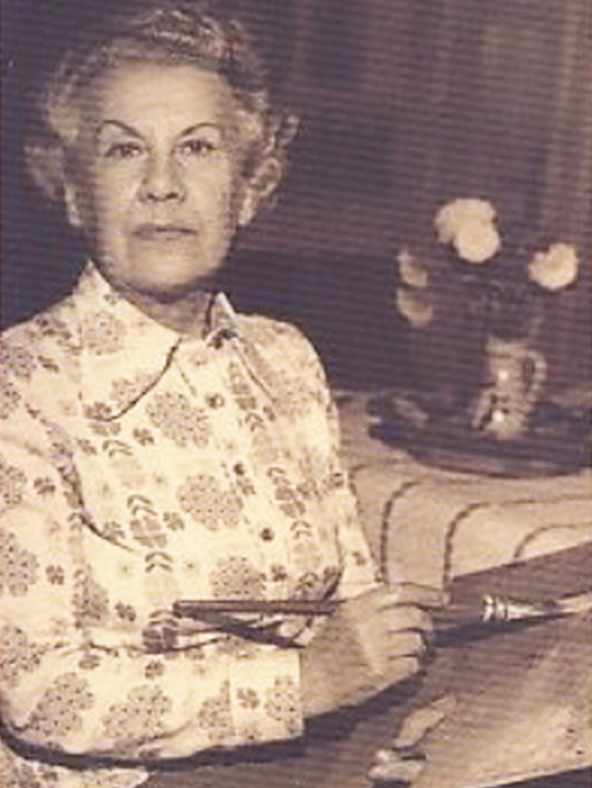Gottlieb Rózsa

1918, Oradea - Cologne, 2012
The Life
Rózsa Gottlieb is, as her name would suggest, God's beloved human. Although she was born Jewish, she converted to Christianity after having a life-saving moment in a concentration camp in Ukraine. She was forced by circumstances to interrupt her studies many times over, but every time she returned to doing what she loved most.
The Art
Gottlieb's art has a subtle, spiritual nuance to it. Although her paintings are inspired by her life experiences, she manages to stay away from realism by adding a sacred dimension to her scenes, thus placing her art into a different category.
Modest beginnings
Rózsa Gottlieb was born into a mixed Jewish family.
Her ancestral tree branches out from a Sephardic Jewish family on her mother's side and intertwines with those of her father, an Orthodox Jew. When she was four years old, her family moved to Targu Mures, into a large apartment in the center of the city, following her father's career as a teacher, who after Romania's Great Union Day in 1918, got a teaching position at a school where it wasn't necessary to speak Romanian.
After moving there, the family's financial situation worsened due to the great economic crisis which made it difficult for the teacher's daughters to get an education. As a student, Rózsa criticizes the rigid atmosphere of Targu Mures. The great economic crisis leads, among other things, to the closure of the high school where she was a student, therefore making her move to Oradea to continue her studies. She enrolled in the high school founded by her grandfather Jakab Gabel, in a more emancipated and liberal environment where she felt more at ease.
Marching to the beat of her heart
Rózsa's life story was subordinated and marked primarily by a series of love encounters. After graduating from Gabel Highschool, she returned to Targu Mures where she decided to take art classes, therefore enrolling in the Art School led by Aurel Ciupe. To cover her school expenses, she got a job in a chemistry lab but later, was forced to give up her studies to continue earning money.
Guided by love, she ends up going to Budapest, where she enrolled at the "Atelier" and specializes in advertising graphics. It is here, in the capital, where she met the great writer Karinthy Frigyes, who helped her get close to the important cultural-artistic circles of the time. Two years later, she is forced to abandon her studies again and move to Targu Mures, but this time under the pressure of anti-Semitic laws, which forbade Jews from studying. Soon after, she moved to Bucharest where she met Elemér, a Jewish worker whom she quickly married on the 11th of July, 1940.
Always believing
Right after their wedding, the Soviet Union had obtained Bukovina and Bessarabia. Everyone was fleeing to save their lives, so the couple learned about the borders being open in Galati and managed to escape from Romania. Elemér was a communist therefore it was imperious that he left the country.
They arrived in Chernivtsi, where they tried to lay down some roots and had their daughter Katica. Here, Rózsa capitalized once again on her artistic knowledge, this time in the realization of realistic socialist portraits. The artist described the shortcomings of communism: poverty, terror, and deportations to Syberia, which made her fear for the life of her family. In 1941, Bukovina was occupied by Romanians and Germans. It was the time when anti-Semitic measures were taken against the Jews and deportation to labor camps in Transnistria began.
The family got caught in a series of unfortunate events and was deported to Mogilyov Ukraine. In the deportation stations, they were suffering from cold and hunger, which was a great challenge not only for Rózsa and her husband but especially for their baby. This is the place and moment in time when Gottlieb said she felt the love of God and converted to Christianity. It was Christmas Day 1941 when she prayed that at least on Jesus' birthday, her family could eat real bread. And the miracle happened! She was given three loaves of bread in the camp's storehouse. The miracle of the three loaves gave her hope that all three were meant to survive.
They remained in that camp until 1943 when Rozsa and her daughter escaped with the help of a Romanian soldier. The two crossed the border into Romania and were hidden by a Romanian woman somewhere near Bacau. Soon after, they arrived in Bucharest where the artist's relatives lived. Because it was impossible to hide them both, the two got separated. Gottlieb had to survive without information about her daughter and husband until the end of WWII. She was reunited with them in April 1944, but the happiness of their reunion was overshadowed by the news that their parents, deported from Transilvania, had died in a labor camp.
Making art her true religion
After the war, the family settled in Cluj, where Rózsa found work in commerce. She soon started studying painting at the Ion Andreescu Institute, where she was taught by Mohy Sándor. In her memoirs, she recalled that even in the immediate aftermath of the war, she read books by Rudolf Steiner, Jiddu Krishnamurti, Baktai Ervin, and others, belonging to a baron who was her neighbor. From all these readings, she was most impressed by the Sanskrit poem "The Sound of Silence". Of course, all these were forbidden readings in a country whose ideology was dialectical materialism, but it helped the artist to better understand her direction: "In me, there was a burning desire to know the secrets beyond our known world of the four dimensions, and venture into new regions".
At school, she couldn’t come to terms with the demands of socialist realism, but Professor Mohy Sándor managed to shed light on her academic education. Mastering realism was beneficial, as it provided a solid basis for young people to follow their path. Starting with 1952, Gottlieb was the main draftsman of Bolyai University, later known as Babeș-Bolyai. There, she made drawings for teachers' communications, and also made extensive illustrative paintings for natural sciences. She attended the workshop in Unirii Square of Incze Ferenc, a marginalized surrealist painter. She approached the art of Fülöp Antal Andor, also a painter marginalized for his spiritualized paintings. She frequented the "salon" of the painter Karácsony Emmy, which was a meeting place for Hungarian intellectuals. She began writing poetry and articles about artists. Around the age of 50, she converted to Christianity, spirituality which nourished her art. However, only later, around 1970, she began creating paintings in this direction, paintings completely detached from realism and inspired by the spirit world. She exhibited them at the Small Gallery of UAP.
After retiring, she had enough time on her hands to grow the passion she had for art. This is how she defined the relationship between drawing and color in her art: “IT [drawing] is life in motion, in change, embraces and gives a wide boost to my imagination, breaks the barriers of reality. When I draw lines, I feel that I am free, that nothing binds me, that the world is mine. [...] Color is never aggressive. It's quietly waiting for me to call it. IT (color) was born into a world of peace and harmony, it is obedient and gentle, it gives orders slowly and yet it has great power. The line is the reason, color is the feeling. I did their wedding, obviously in my way, independent of others."
In 1977 she organized her second exhibition, at the Korunk Gallery in Cluj, whose presenter was the excellent art historian E. Szabó Ilona. Szabó shed light on the artist's late artistic career, emphasizing that her art is entirely inspired by imagination and that she is dedicated to a moral duty to look forward to existence. In this exhibition, the painting "Waiting" from our collection was also presented. E. Szabó Ilona noted that Gottlieb's art has long roots, which burry deep into her childhood and resurface into her adulthood.
In 1988 she moved to Cologne, where her daughter lived. She participated actively in the German cultural life and also exhibited there. HerAuschwitz painting was exhibited in Cologne and was included in the Yad Vashem collection in Jerusalem.
In her memoirs "Az emlékezés mélyvízeiben" (In the deep waters of memories) one can observe the extremely subjective view on life. Gottlieb Rózsa was not interested in the great events or phenomena of the time, but in the relationships forged between people and the richness of the inner self. She passed away in 2012, in Cologne.

